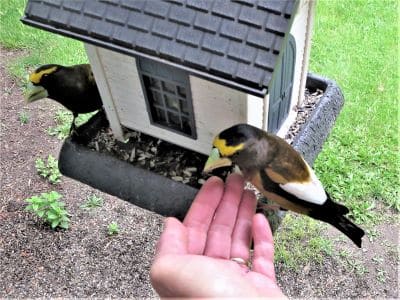For the earnest expectation of the creation eagerly waits for the revealing of the sons of God. For the creation was subjected to futility, not willingly, but because of Him who subjected it in hope; because the creation itself also will be delivered from the bondage of corruption into the glorious liberty of the children of God. Romans 8:19-21
There is something very special which takes place whenever I have the privilege of touching a wild animal. It is beyond words. Most of the times when this happens, I have no chance of getting a picture, but on rare occasions I capture the moment on camera. I wrote a little about this when I got to touch a wild deer after taking a break from shoveling snow a few years back (see Deer Touch).
As I’ve mentioned before, if you spend time in the outdoors, you may get the opportunity to touch a young animal. Some research indicates that deer fawns have no scent. It may be the same with elk and moose and others in that family. This is a defense against predators. For that reason, and others, the scent from a human touch may be the touch of death for the animal. Adults may reject young which are “contaminated” with human scent. This can also happen with birds. Adults will even toss out viable eggs from a nest if they have foreign scent.
So, if you see a young animal, please just take a few quick pictures if you want, and leave the area. Unless you know for certain that the parents have died, it is likely that they are nearby watching you as you are close to their young. If the watching adult is one that can hurt you, like a moose or bear, etc., I suggest you get away to safety as soon as possible and forget the pictures. You’ll still have the experience to remember, even if no one else believes you!
The birds pictured above are male evening grosbeaks. I like the look of the one on the left as he cranes his neck around the feeder to see who or what in the world is reaching out the window to them.
An evening grosbeak is about the size of a robin. As you can see, the males have dark heads with bright yellow stripes above their eyes. They also have white patches on their wings, and pale, ivory-colored bills. The females are mostly gray and black, and their bills are more greenish than those of the males.
Food sources for these birds are numerous. They eat caterpillars, aphids, and budworm larvae. They will eat buds from several trees such as maple, cherry, and aspen. They also like a wide variety of seeds from trees such as alder, maple, and cherry. Their strong bills allow them to actually crack a cherry seed before swallowing it. You’ll want to check with your dentist before attempting this feat!
These birds sometimes travel in large flocks. So, if they find your birdfeeder, they can clean it out in a hurry. But if they do come by, and you’re really patient, you may just get to touch one yourselves. How cool is that?
The above Scripture speaks about the revealing of the children of God. Not sure how to be one? Please see Got God?
Hope you have a great day.


 Mountain Vapor and Clouds
Mountain Vapor and Clouds
Leave a Reply